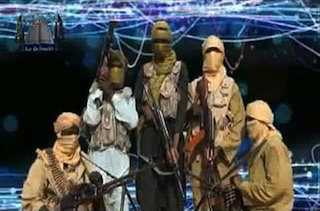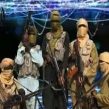
Ansaru: A Profile of Nigeria’s Newest Jihadist Movement
Publication: Terrorism Monitor Volume: 11 Issue: 1
By:

After the death of Boko Haram founder and leader Muhammad Yusuf in July 2009, Nigerian security forces killed up to 1,000 Boko Haram members over a four-day period that month and arrested hundreds of other members in order to – in the words of then-Nigerian President Yar’Adua – “crush” Boko Haram. Yusuf’s closest followers, including his deputy Abu Shekau and third-in-command Mamman Nur, moved underground and began operating clandestinely, evolving from Taliban-inspired Salafists into insurgents identifying with al-Qaeda. When Boko Haram launched an attack on Bauchi prison on September 7, 2010 to free more than 100 members detained in 2009 it also distributed pamphlets signed by Shekau threatening revenge on “whoever had a hand in killing our members from the state governor down to ward and district head” (Daily Trust [Lagos], September 9, 2010).
Shekau’s movement is commonly called Boko Haram, though the full name is Jama’atu Ahlisunnah Lidda’awati wa’l-Jihad (the Group for the Propagation of the Prophet’s Teachings and Jihad). Since its assault on Bauchi prison, the group has been responsible for 500 attacks with a death toll of more than 3,000 people. However, a dissident faction that rejects Shekau’s leadership emerged in January 2012, using the name Jama’atu Ansaril Muslimina fi Biladis Sudan (Vanguard for the Protection of Muslims in Black Africa, or simply “Ansaru”) (Vanguard [Lagos], February 1, 2012). This new movement appears to coordinate its operations in Nigeria with the northern Mali-based al-Qaeda in the Islamic Maghreb (AQIM) and the Movement for Unity and Jihad in West Africa (MUJWA). This faction may therefore be the most imminent threat to foreign interests in Nigeria, while Shekau’s faction of Boko Haram may be the more long-term strategic threat.
Boko Haram: Friend and Foe
On November 30, 2012, Ansaru sent an e-mail to a northern Nigerian media outlet and released a separate Hausa language video to claim responsibility for the November 25 prison break at the Special Anti-Robbery Squad (SARS) headquarters in Abuja. Although Nigerian police claimed that only five prisoners escaped, Ansaru alleged that it freed 37 members and 286 other prisoners who were subject to “real human rights violations,” including “extra judicial killings,” “termites” and “a complete lack of water” (This Day [Lagos], November 26). [1] On November 29, Shekau praised the operation in his own video, which featured Shekau and other militants training with rocket-propelled grenades and other weapons in an unknown desert location. Shekau offered “glad tidings” on the prison-break, claiming it free “more than 150 mujahideen.” [2] Among the Boko Haram members freed from the prison was the wife of Kabiru Sokoto, the mastermind of the 2011 Christmas Day church bombings outside of Abuja (Vanguard, April 6; Daily Independent [Lagos], November 27).
That Ansaru and Shekau’s faction of Boko Haram were united in praising the prison break is consistent with Ansaru’s June 5 statement that it would “compliment” its “brothers” in Boko Haram, but would distance itself from Boko Haram when the movement does “bad things” (Desert Herald, June 5). In a November 26 statement, Ansaru elaborated on these “bad things” when it accused Shekau of ordering the killing of an Ansaru member for “taking a moderate stance on religious matters,” “going too far in his interactions with people” and justifying his leadership with “extreme actions.” [3] When Ansaru first announced its existence publicly on January 26, 2012 by distributing fliers in Kano after Boko Haram attacks in the city killed approximately 150 Muslim civilians, media reports described Ansaru’s emergence as a reaction to the “loss of innocent Muslim lives” (Vanguard, February 1, 2012). In a June 2 video, Ansaru said that the sin of killing a fellow Muslim was second only to the sin of accepting laws other than the Shari’a and in a November 9 video Ansaru described the killing of Muslims as "inexcusable." [4]
Backlash against Shekau
Despite Ansaru’s differences with Boko Haram, the group maintains that Ansaru and Boko Haram are like “al-Qaeda and the Taliban, pursuing similar objectives and engaging in the same struggle, but with different leaders” (Desert Herald, June 5). Ansaru says its leader is Abu Usmatul al-Ansari, who appears with a veil covering his face in videos, and that its spokesman is Abu Jafa’ar, both of which are likely pseudonyms. Though Ansaru did not declare its formation until January 2012, UK Home Office Minister Mark Harper suggested the group was responsible for the May 2011 kidnapping of a British and Italian engineer, both of whom were subsequently killed by their captors during a failed rescue attempt by the UK’s Special Boat Squadron (SBS) in March 2012 (BBC, November 22, 2012). [5] Responsibility for the kidnappings was claimed in two videos by a previously unknown group calling itself “al-Qaeda in the Lands Beyond the Sahel,” though Nigerian security forces believed those responsible were a faction of Boko Haram (Guardian, March 9, 2012).
French news agency AFP reported that a Boko Haram informant claimed one of those responsible for the kidnappings was Khalid al-Barnawi a native of Nigeria’s Borno State who is alleged to have trained with al-Qaeda in the Islamic Maghreb (AQIM) in Algeria in the mid-2000s and then carried out kidnappings of foreigners in Niger and Nigeria (AFP, June 21, 2012). He is also one of three Nigerians, including Abu Shekau, whom the United States designated as “global terrorists” in June 2012 and whom Nigeria declared “Most Wanted” in November 2012 for being on Boko Haram’s Shura Council (This Day, November 24). [6]
Ansaru’s leaders are among the many militants in northern Nigeria who reject Shekau’s leadership. After Muhammad Yusuf’s death, Boko Haram’s Cameroonian third-in-command, Mamman Nur, fell out with Shekau when Nur took over the leadership of the movement while Shekau recuperated from gunshot wounds suffered in the July 2009 clashes. Nur loyalists believed Nur was fit to lead because of his international contacts, including alleged contacts with Somalia’s al-Shabaab. However, Shekau succeeded in using his fearful reputation to emerge as the Boko Haram leader; according to a Boko Haram spokesman, “nobody even dared ask [Shekau] questions for fear of death” (Vanguard, September 3, 2011). When Shekau issued his first statement in July 2010, he said that “being the deputy to Yusuf,” he had “stepped in and assumed the leadership.” His leadership style came under rebuke in July 2011 when a group called the Yusufiya Islamic Movement distributed fliers in Kano calling on the “evil group” (i.e. Boko Haram) to desist and urged Muslims to “pray that Allah exposes those who perpetrated [bombings targeted at civilians]” (The Nation [Lagos], July 21, 2011).
Nur went on to mastermind the bombing of the UN Headquarters in Abuja on August 26, 2011 and is part of the team that Boko Haram factional leader Abu Muhammad is proposing for negotiations with the Nigerian government in Mecca, Saudi Arabia. However Shekau’s Boko Haram faction has called Abu Muhammad’s faction “fake” and denied any connection to his group (Sahara Reporters, August 23, 2012). Nur and his loyalists were also reported to have assassinated Mohammed Yusuf’s cousin, Babakura Fugu, in September, 2011 after he negotiated with the government for compensation for Yusuf’s death. Shekau’s group condemned this assassination as “immoral” (Vanguard, September 19, 2011).
Threat to Foreigners
Ansaru claimed responsibility for an operation on December 19, 2012 in which 30 militants raided an engineering company’s compound in Katsina (30 miles from the border with Niger) and kidnapped a Frenchman. Ansaru warned France that it would continue launching attacks against the French government and French citizens until France ends its ban on the Islamic veil and its “major role” in the planned intervention in northern Mali (This Day, December 24, 2012).
Another kidnapping of a German engineer in Kano on January 26, 2012, was claimed by AQIM through AQIM’s al-Andalus media wing and appears to have been connected to the kidnapping of the British and Italian men. The kidnappers, for example, warned Germany not to forget “the lesson taught to the British by the mujahideen” in Sokoto and the proof-of-life videos in both kidnappings were sent to the same Mauritanian news agency, Agence Nouakchott Internationale, which regularly receives AQIM videos. In contrast to AQIM, Ansaru and MUJWA, Shekau’s spokesman has denied that Shekau’s faction of Boko Haram engages in hostage-taking or ransoms, and, as a matter of verification, there have been no reports of kidnappings in northeastern Nigeria where Shekau’s faction is most active (Sahara Reporters [Lagos], March 9, 2012).
Conclusion
There are several factions in northern Nigeria that have taken up arms against the Nigerian government since the death of Mohammed Yusuf in 2009. Most of these factions are likely connected through the relationships that Shekau, al-Barnawi, Nur and other militants had before Boko Haram went underground. Shekau has been the main face of the insurgency in northern Nigeria, but his record as a divisive, albeit effective and fearsome leader and Boko Haram’s killing of innocents has bred dissent. Now Ansaru is gaining prominence due to its kidnapping of foreigners in northern Nigeria, prison break operation in Abuja and a media strategy that challenges Shekau.
As 2009 recedes into the past, a split will probably emerge in Boko Haram between Nigeria-oriented and internationally-oriented militants. The former group’s grievances are against the Nigerian government and largely inspired by a desire for revenge for the killing of Muhammad Yusuf and his followers in July 2009. The latter group, which includes Ansaru, will likely compliment AQIM and MUJWA through its operations in northern Nigeria and attract members who have trained with AQIM, such as al-Barnawi, or with al-Shabaab, like Nur. Shekau may also become more internationally oriented if, as some reports suggest, he has fled Nigeria and received refuge in northern Mali with other Boko Haram commanders.
Jacob Zenn is an analyst of African and Eurasian Affairs for The Jamestown Foundation and author of the Occasional Report entitled “Northern Nigeria’s Boko Haram: The Prize in al-Qaeda’s Africa Strategy,” published by The Jamestown Foundation in November 2012. In 2012, he conducted field research in Nigeria, Niger, Chad and Cameroon on the socio-economic factors behind the Boko Haram insurgency.
Notes
1. “Declared of Jama`atu Ansaril Muslimina Fibiladis Sudan Garki II Abuja,” YouTube, November 30, 2012, https://www.youtube.com/watch?v=_1m5-zV3zfU.
2. "Glad Tidings, O Soldiers of Allah," Ana al-Muslim Network, December 1, 2012, https://www.shamikh1.info/vb/showthread.php?t=188204.
3. “Important Message From Jama`atu Ansaril Muslimina fi Biladis Sudan,” YouTube, November 26, 2012, https://www.youtube.com/watch?v=aZ-6STrj2tI
4. “Video of Introduction of Jama’atu Ansaril Muslimina fi Biladis-Sudan,” YouTube, November 9, 2012, https://www.youtube.com/watch?v=s6ATD6bLaBI.
5. Ansaru was proscribed by the UK government on November 22, 2012, though its connection to the kidnapping was not mentioned in the legislation. See https://www.legislation.gov.uk/uksi/2012/2937/pdfs/uksi_20122937_en.pdf.
6. U.S. Department of State, “Terrorist Designations of Boko Haram Commander Abubakar Shekau, Khalid al-Barnawi and Abubakar Adam Kambar,” June 21, 2012, https://www.state.gov/r/pa/prs/ps/2012/06/193574.htm.





